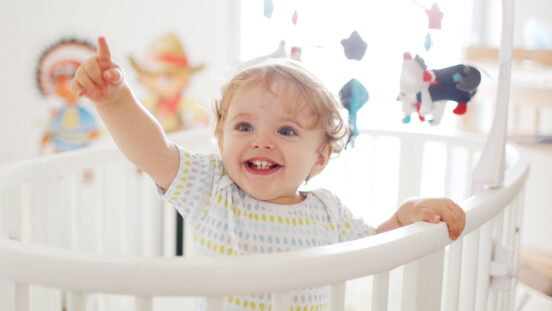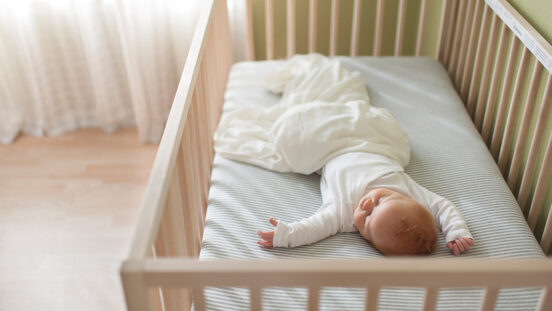Inclined sleeping danger: A tragedy waiting to happen
CHOICE is calling on the government to introduce tighter product safety laws
Allowing bub to stay asleep in a car seat, pram or rocker can be tempting. After all, they’re finally asleep and nobody wants to risk waking a sleeping baby by moving them.
But the harsh truth is that the danger to infants who sleep on an incline are significant, which is why the fact that some companies are creating products designed for inclined sleeping is mind-blowing. Perhaps even more concerning is the lax approach to safety laws in Australia when it comes to these products.
73 infant deaths have been linked to inclined sleepers in the US, statistics that have CHOICE calling on the Australian government to introduce tighter product safety laws here.

Inclined surfaces can cause an infant’s head to fall forward onto their chest, posing a huge suffocation risk (Illustration by Chris Philpot for Consumer Reports)
CHOICE experts say that based on research conducted in the US, inclined sleepers are so dangerous for young babies that they should be completely avoided.
Two inclined sleeping products have been recalled in Australia in recent years – the Rock ‘N Play and Kids2 sleepers – but the Federal Government needs to step up and prevent unsafe products from getting into Australian homes in the first place.
“At the moment, the public is being treated as a testing lab for dangerous products. Safety tests should be conducted in factories, not in people’s homes,” says product safety campaigner, Amy Pereira.
“Inclined sleepers are particularly hazardous because of their soft, sloped surface. This kind of surface may increase the risk of sudden and unexpected death, as babies can roll over or have their head fall forward while in them and suffocate.”
“We’ve seen countless examples of unsafe products flooding our homes,” says Pereira. “It shouldn’t be up to the person buying the product to check whether it’s going to harm them or not. They should be able to assume it’s safe.”
“Australians need a new product safety law to put responsibility where it should be – with the manufacturer, to ensure that their product is safe before it’s sold.”
WATCH: CHOICE expert Kim Gilmour explains what safe and unsafe sleeping environments for infants look like. Continues after video …
CHOICE is calling for a General Safety Duty. This involves introducing a new section on product safety into the Australian Consumer Law so that all products will be subject to basic and sensible safety checks before going on sale.

Inclined surfaces pose a huge suffocation risk to infants (Illustration by Chris Philpot for Consumer Reports)
Safe sleeping tips
Sydney’s sleep expert Cheryl Fingleson from Cheryl the Sleep Coach reminds new parents that there are some simple but proven tools to keep baby secure, warm and safe as he or she learns the challenging art of sleeping well.
1. Sleep baby on their back from birth – never on their tummy or side
- Babies up to one year of age should always be placed on their back to sleep during naps and at night.
- If your baby falls asleep in a car seat, stroller, swing, infant carrier, or infant sling, she should be moved to a firm sleep surface as soon as possible.
- Swaddling is a proven method of calming a crying or fussy baby. Place the wrapped baby at the bottom of the cot with his feet almost touching the bottom railing.
2. Use appropriate bedding
- When using bedding, put baby’s feet at the end of the cot then only bring bedding up to the chest.
- Never allow the baby’s face to become covered.
- When using a sleeping bag, make sure it is the right size for your baby and the right thermal rating for the season.
3. Avoid exposing baby to tobacco smoke before and after birth
- If you smoke, try to quit. And if you can’t, keep your car and home smoke-free. Never smoke anywhere near your baby, even if you are outside.

Sleep coach, Cheryl Fingleson says parents should know that they don’t have to feel like they’re struggling through the journey on their own, and can always get help from a trained professional.
4. Sleep baby in the same room, but not in the same bed
- If it works for both baby and parents, room sharing is a safe thing to do.
- Keep the cot or bassinet within an arm’s reach of your bed. You can easily watch or breastfeed your baby by having your baby nearby.
- It is not ideal to sleep in the same bed as a newborn. This places them at greater risk of SIDS, suffocation, or strangulation. Parents can roll onto babies during sleep, or babies can get tangled in the sheets or blankets.
5. Provide a safe sleeping environment for baby night and day.
- The cot, bassinet, porta-cot, and mattress should meet current safety standards. Never use a cot that is broken or has missing parts.
- Cover the mattress with a tight-fitting sheet.
- Do not put blankets or pillows between the mattress and fitted sheet.
- Never put your baby to sleep on a play rocker, a water-bed, a cushion, or a sheepskin.
- Pillows, quilts, comforters, sheepskins, bumper pads, and stuffed toys are risky and should not be left in the unattended cot of a young baby.
Don’t allow baby to become too hot.




